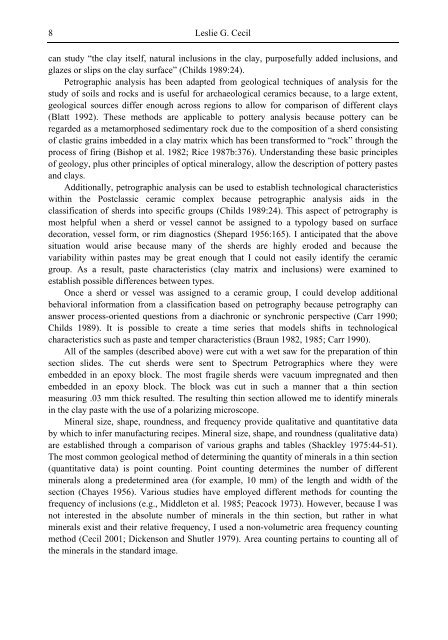Developments in Ceramic Materials Research
Developments in Ceramic Materials Research
Developments in Ceramic Materials Research
Create successful ePaper yourself
Turn your PDF publications into a flip-book with our unique Google optimized e-Paper software.
8<br />
Leslie G. Cecil<br />
can study “the clay itself, natural <strong>in</strong>clusions <strong>in</strong> the clay, purposefully added <strong>in</strong>clusions, and<br />
glazes or slips on the clay surface” (Childs 1989:24).<br />
Petrographic analysis has been adapted from geological techniques of analysis for the<br />
study of soils and rocks and is useful for archaeological ceramics because, to a large extent,<br />
geological sources differ enough across regions to allow for comparison of different clays<br />
(Blatt 1992). These methods are applicable to pottery analysis because pottery can be<br />
regarded as a metamorphosed sedimentary rock due to the composition of a sherd consist<strong>in</strong>g<br />
of clastic gra<strong>in</strong>s imbedded <strong>in</strong> a clay matrix which has been transformed to “rock” through the<br />
process of fir<strong>in</strong>g (Bishop et al. 1982; Rice 1987b:376). Understand<strong>in</strong>g these basic pr<strong>in</strong>ciples<br />
of geology, plus other pr<strong>in</strong>ciples of optical m<strong>in</strong>eralogy, allow the description of pottery pastes<br />
and clays.<br />
Additionally, petrographic analysis can be used to establish technological characteristics<br />
with<strong>in</strong> the Postclassic ceramic complex because petrographic analysis aids <strong>in</strong> the<br />
classification of sherds <strong>in</strong>to specific groups (Childs 1989:24). This aspect of petrography is<br />
most helpful when a sherd or vessel cannot be assigned to a typology based on surface<br />
decoration, vessel form, or rim diagnostics (Shepard 1956:165). I anticipated that the above<br />
situation would arise because many of the sherds are highly eroded and because the<br />
variability with<strong>in</strong> pastes may be great enough that I could not easily identify the ceramic<br />
group. As a result, paste characteristics (clay matrix and <strong>in</strong>clusions) were exam<strong>in</strong>ed to<br />
establish possible differences between types.<br />
Once a sherd or vessel was assigned to a ceramic group, I could develop additional<br />
behavioral <strong>in</strong>formation from a classification based on petrography because petrography can<br />
answer process-oriented questions from a diachronic or synchronic perspective (Carr 1990;<br />
Childs 1989). It is possible to create a time series that models shifts <strong>in</strong> technological<br />
characteristics such as paste and temper characteristics (Braun 1982, 1985; Carr 1990).<br />
All of the samples (described above) were cut with a wet saw for the preparation of th<strong>in</strong><br />
section slides. The cut sherds were sent to Spectrum Petrographics where they were<br />
embedded <strong>in</strong> an epoxy block. The most fragile sherds were vacuum impregnated and then<br />
embedded <strong>in</strong> an epoxy block. The block was cut <strong>in</strong> such a manner that a th<strong>in</strong> section<br />
measur<strong>in</strong>g .03 mm thick resulted. The result<strong>in</strong>g th<strong>in</strong> section allowed me to identify m<strong>in</strong>erals<br />
<strong>in</strong> the clay paste with the use of a polariz<strong>in</strong>g microscope.<br />
M<strong>in</strong>eral size, shape, roundness, and frequency provide qualitative and quantitative data<br />
by which to <strong>in</strong>fer manufactur<strong>in</strong>g recipes. M<strong>in</strong>eral size, shape, and roundness (qualitative data)<br />
are established through a comparison of various graphs and tables (Shackley 1975:44-51).<br />
The most common geological method of determ<strong>in</strong><strong>in</strong>g the quantity of m<strong>in</strong>erals <strong>in</strong> a th<strong>in</strong> section<br />
(quantitative data) is po<strong>in</strong>t count<strong>in</strong>g. Po<strong>in</strong>t count<strong>in</strong>g determ<strong>in</strong>es the number of different<br />
m<strong>in</strong>erals along a predeterm<strong>in</strong>ed area (for example, 10 mm) of the length and width of the<br />
section (Chayes 1956). Various studies have employed different methods for count<strong>in</strong>g the<br />
frequency of <strong>in</strong>clusions (e.g., Middleton et al. 1985; Peacock 1973). However, because I was<br />
not <strong>in</strong>terested <strong>in</strong> the absolute number of m<strong>in</strong>erals <strong>in</strong> the th<strong>in</strong> section, but rather <strong>in</strong> what<br />
m<strong>in</strong>erals exist and their relative frequency, I used a non-volumetric area frequency count<strong>in</strong>g<br />
method (Cecil 2001; Dickenson and Shutler 1979). Area count<strong>in</strong>g perta<strong>in</strong>s to count<strong>in</strong>g all of<br />
the m<strong>in</strong>erals <strong>in</strong> the standard image.
















